Popular impressionist painters in Japan include Renoir and Monet, who painted bright light with gentle colors. In this issue, we will look back on Renoir's painting career and learn about his representative works.
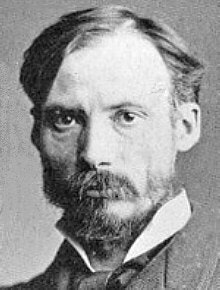
Renoir from his childhood to his artisan days
Renoir was born in 1841 in Limoges, a porcelain town in south-central France.
His father, Leonard, was a tailor, and his mother, Marguerite, a seamstress. While later impressionist painters came from the bourgeoisie, Renoir came from a working-class background.
In 1844, Renoir and his family moved to Paris.
They settled near the Louvre, in what was then a poor neighborhood. Renoir showed an interest in painting from an early age, but he also had a beautiful voice. Around 1850 (around age 9), he joined the choir of Saint-Eustache church, led by the composer Charles Gounod, and learned vocal music from Gounod.
Gounod highly praised Renoir's talent as a singer and proposed to Renoir's parents that he join the chorus of the Opera, but when an acquaintance of his father's offered to hire Renoir as an apprentice at a porcelain factory, Renoir turned down Gounod's proposal and quit the choir as well. In 1854, he joined the porcelain factory.
In 1854, he joined a porcelain factory and became an apprentice to a porcelain painter, but the industrial revolution and mechanization affected the traditional world of porcelain painting, and he lost his job as a craftsman in 1858.
Renoir next turned to fan decoration as a career, repeatedly painting fans that reproduced famous masterpieces by Antoine Vatto and François Boucher.
At this time, Renoir seems to have developed an interest in 18th century rococo paintings by Boucher and Jean Honoré Fragonard. He then undertook a series of artisanal jobs, including coat of arms painting for medal production, decorating window awnings, and decorating the walls of cafes.
In between jobs, he attended a free drawing school, and in 1860 he received permission to make copies at the Louvre. It is said that he was particularly fond of Rubens, Boucher, and Fragonard, who were considered colorists.
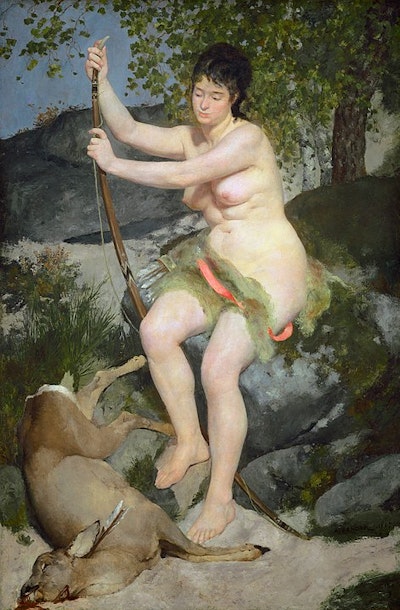
Meeting his peers at Charles Grelle's painting school
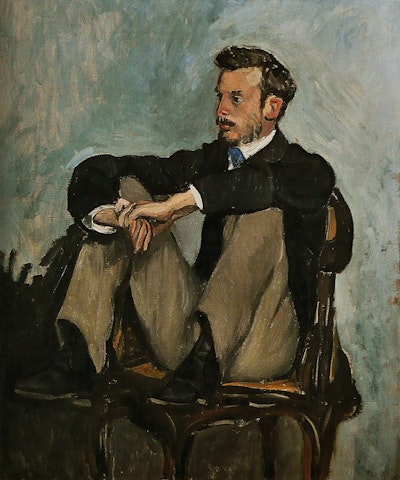
Renoir decided to become a painter, and in November 1861, he entered Charles Gleyre's atelier (painting school). It was here that he met fellow painters who would later become known as the Impressionists, including Claude Monet, Alfred Sisley, and Frédéric Bazille.
He also met Henri Fantin-Latour, who had a studio nearby.
Although Gleyre himself was a conservative academic painter, he allowed his students to paint freely using models at a low cost, which is said to have attracted a variety of painting students with different tendencies.
Renoir later recalled that Grelle was "no help to his pupils," but had the advantage of "letting them do what they wanted.
When Grail saw Renoir's use of color while working at the school, he said, "You must really enjoy scratching around in paint, don't you?" Renoir replied, "Of course. If I didn't enjoy it, I wouldn't do it. Renoir is known to have responded, "Of course, I wouldn't do it if I didn't enjoy it.
Monet and Renoir grew increasingly sympathetic to Grayle's conservative approach.
Unlike Monet, however, who disliked the Louvre, Renoir went there with his friend Henri Fantin-Latour and preferred to study 18th century French painters.
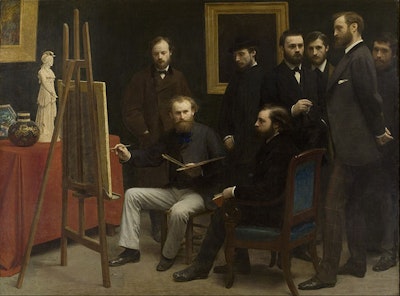
In April 1862, he also enrolled at the Ecole des Beaux-Arts (government art school), where he received a parallel classical drawing education.
When he brought an oil painting study to class, Signor, the teacher, criticized him for his use of red color and warned him, "Be careful not to become another Delacroix! He was warned, "Be careful not to become another Delacroix!
At the time, Delacroix's use of rich colors was frowned upon by the neoclassical academy, which emphasized drawing.
In the 1863 composition examination at the Ecole des Beaux-Arts, he was ranked ninth out of 12 examinees, and in the 1864 engraving and drawing examination, he was ranked tenth out of 106.
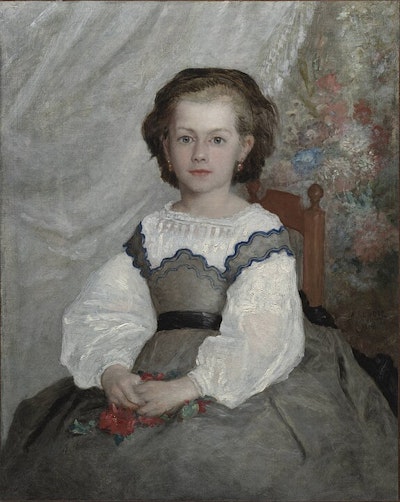
In 1863, he went to Chailly-en-Bières with Bazille, Monet, and Sisley to sketch in the forest of Fontainebleau.
While Renoir was working outdoors, a man with a prosthetic leg appeared and asked him, "Your drawing is not bad, but why on earth did you paint it so black?
This man was Narcisse Virgile Diaz de la Peña, a painter of the Barbizon School, and Diaz later came to support and advise Renoir, who was struggling financially, with the cost of art supplies, and Renoir came to respect Diaz as well.
It is said that Grelle's painting school was closed that year.
Challenge to the Salon
His first entry to the Salon de Paris in 1863 was unsuccessful.
He entered "Esmeralda" as a "pupil of Gleyre" in the 1864 Salon and was selected. However, this work was painted over by Renoir himself after the Salon and has not survived.
It is said to have been a dark painting with a Romantic subject, based on Victor Hugo's "Notre Dame de Paris.
In 1864, a porcelain manufacturer commissioned him for the first time to paint a portrait of his nine-year-old daughter, Mademoiselle Romaine Lacaux. The influence of Velázquez, Angle, Corot, and Edgar Degas can also be felt in this work.
In 1865, he and Sisley stayed at Marlotte, near the Forest of Fontainebleau. It was at Marlotte that Renoir became acquainted with the painter Jules Le Coeur, who took care of him during his stay.
Le Coeur began a relationship with a woman named Clémence Thoreau, while Renoir met and became acquainted with 17-year-old Lise Thoreau, Clémence's younger sister.
He often used her as a model for his paintings thereafter.
Two of his paintings, including a portrait of Sisley's father, were selected for the 1865 Salon. Sisley had commissioned and purchased the portrait to help Renoir, who was struggling financially.
Again, Renoir exhibited as "Grelle's Apprentice.
For the 1866 Salon, he entered "Jules Le Coeur in the Forest of Fontainebleau.
That year, with Jean-Baptiste Camille Corot and Charles-François Daubigny on the Salon jury, Renoir and many of his fellow painters were selected.
During this period, Renoir experimented with a variety of styles at both ends of the spectrum, from the palette knife, following Courbet, to more academically conceived works, which he reportedly produced in the forests of Fontainebleau and elsewhere.
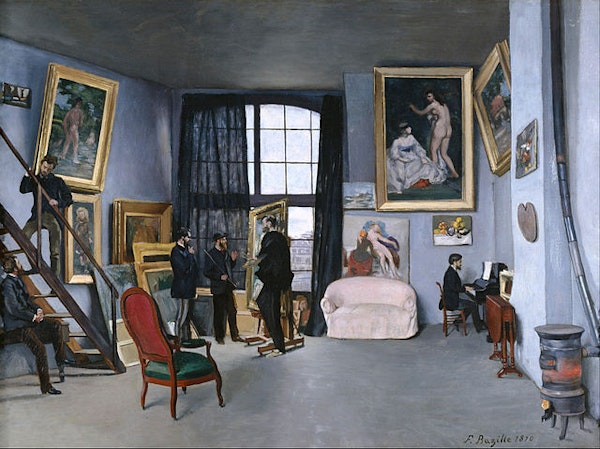
In July 1866, Bazille moved his studio to Rue Visconti, which Renoir also shared.
Sisley and Monet were also frequent visitors.
Bazille, who grew up in a wealthy family in the south of France, helped his fellow painters, including Renoir and Monet, financially and sometimes lived with them in their studios.
In 1867, Basile and Sisley painted the same still life of a green heron from different angles, and Renoir left a painting of Basile during its creation.
Basile also painted a portrait of Renoir.
Manet admired Renoir's portrait of Basile, and Renoir gave the painting to Manet.
The Impressionist Exhibition is held.
First Impressionist Exhibition
On January 17, 1874, the Statutes of the "Joint Company of Painters, Sculptors, Printmakers, and Other Artists" were announced. Its goals included, among others, organizing a free exhibition without judging or reward, and its date of establishment was set for December 27, 1873.
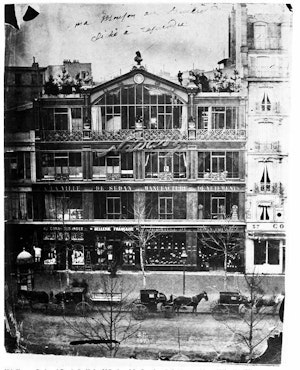
The first exhibition of this joint venture was then held at the photographer Nadar's photo studio on the Boulevard des Capucines (English version) in Paris for a month, beginning on April 15 of the same year, two weeks before the opening of the Salon, and ending on May 15. This historic exhibition, later called the "First Impressionist Exhibition," was attended by 30 painters, with a total of about 165 works on display. The exhibition catalog was produced by his brother Edmond. It is said that Renoir was mainly responsible for the organization of the exhibition.
Renoir exhibited seven works: five genre paintings, including "The Dancer," "The Pier," and "Parisienne (Woman in Blue)," one landscape, and one still life.
.jpg?w=500&h=625)
However, the first exhibition was harshly criticized by the public.
On April 25, soon after the opening of the first exhibition, the critic Louis Leroy published a reportage-style review, "An Exhibition of Impressionism," in the newspaper Le Charivari, in which a visitor to the exhibition was surprised and appalled by the terrible works.
In it, he criticized Renoir's "Dancer," in which he misidentified the artist as "Guillaumain," but also criticized the indistinct outlines of the figures, which seemed to blend into the background. It is ironic that this text led to the public's recognition of the terms "Impressionism" and "Impressionism," which gradually became the name of the group and was even used by the painters themselves.
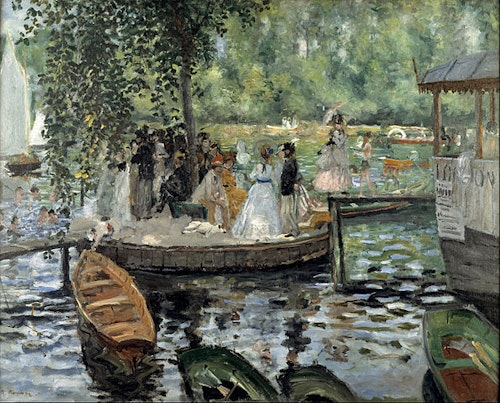
The Second and Third Impressionist Exhibitions
In February 1876, Renoir and his close friend Henri Rouard wrote to Gustave Caillebotte proposing the organization of a second group exhibition. Renoir was enthusiastic, probably because the previous year's auction at the Hôtel Drouot had been unsuccessful, he had been unsuccessful at the Salon, and Manet's Salon-winning work had also been heavily criticized. Schocquet also encouraged this.
In March-April, the second Impressionist exhibition was held at the Durand-Ruel gallery. Renoir exhibited 18 works, including "Study" ("Nude in the Sunlight").
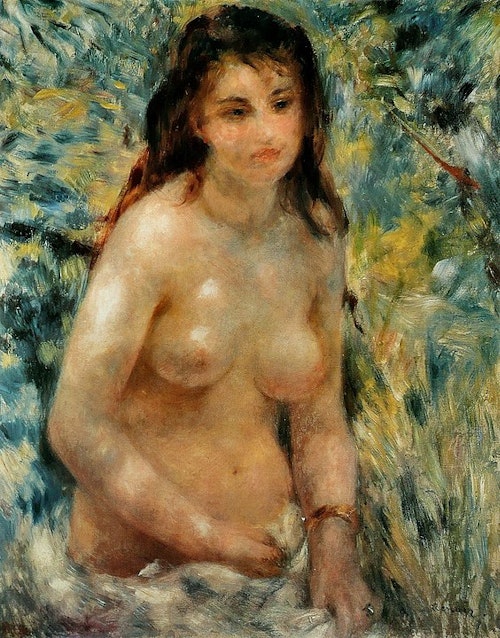
However, he was subjected to the following harsh criticism.
Now, I would like Mr. Renoir to explain the following. That the female torso is not a mass of decomposing flesh with purplish green spots, indicating the complete decomposition of the corpse!"
- Albert Wolff, Figaro, April 3, 1876.
This is a critique of Renoir's "Nude in the Sunlight," which shows that Renoir's use of purple and green to represent the shadows falling on the skin out of doors was not understood from the standpoint of academic painting, which emphasized the intrinsic colors of objects and only showed them as decomposing.
Emile Zola, on the other hand, admired Renoir's portraits.
Challenge and Return to the Salon (government exhibition)
At the urging of Charpentier, Renoir entered the Salon of 1878.
A Cup of Chocolat, which he entered as "a disciple of Gleyre," was selected.
This provoked Sisley, Cézanne, and Monet to apply to the Salon, but Degas insisted that participants in the Impressionist exhibition should not apply to the Salon, and the differences in thinking within the Impressionist group became serious.
At the time, the Salon was a guarantee of recognition of works for the general public, and for Renoir, who came from a working-class background and was struggling financially, being accepted to the Salon and selling his works was a serious problem.
Two of his paintings were selected for the Salon of 1879.
The standing portrait of the actress Jeanne Samarie did not attract much attention, but Madame Charpentier and Her Children was displayed in a prominent position and received much praise.
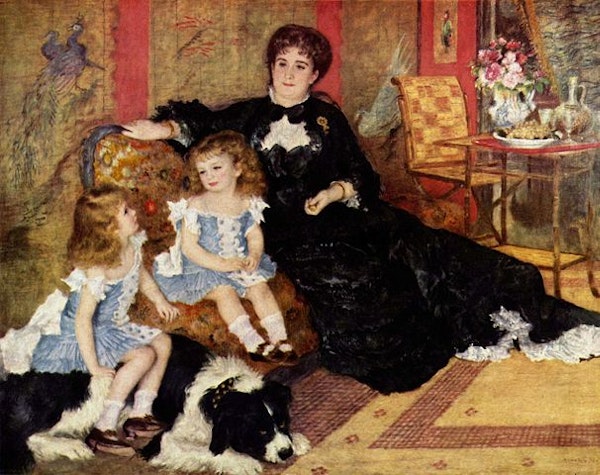
This was largely due to the fame of the model, Madame Charpentier. In the painting, Madame Charpentier is wearing a black dress, which was a challenge to the conventional Impressionist aesthetic.
It is said that she even temporarily stopped painting outdoors.
In a letter to his supporter Eugène Muret, Pissarro wrote, "Renoir was a great success at the Salon. I think he has finally done it. That is very good. Poverty is very painful." He wrote. Marcel Proust, who saw the painting at the Charpentier house, also admired its elegance. From that time on, the number of orders for portraits seems to have increased.
Travels to Algeria and Italy led to a return to Classicism
In October 1881, Renoir suddenly left for Italy, staying first in Venice.
From there, he wrote to Madame Charpentier, "I was possessed by a desire to see Raphael's work." She wrote.
Then, on November 21, he wrote to Durand-Ruel from Naples, "I have seen Raphael's works in Rome. Very wonderful. I should have seen it earlier. ...... I like Dominique Angle for oil paintings. But there is an amazing simplicity and greatness in Raphael's frescoes." He wrote back.
Renoir was initially contemptuous of academic paintings that imitated Raphael and went to see them for a chilling experience, but he was reportedly moved when he saw the Room of Signatures in the Vatican Palace in Rome and Villa Farnesina's "Galatea's Victory".
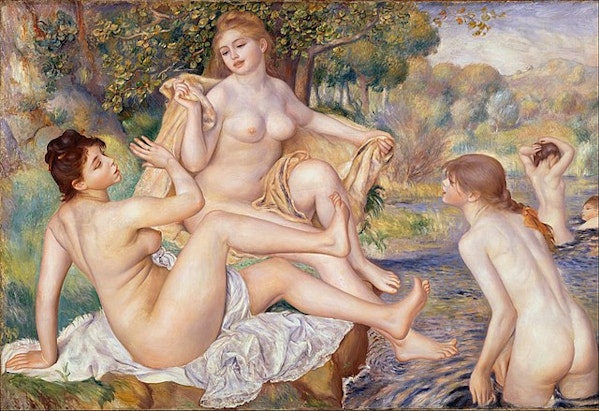
Renoir's encounter with Raphael on a trip to Italy led to his interest in painting from Nicolas Poussin to neoclassicism, and he shifted his emphasis from color to drawing. Then, from around 1883 to 1888, he entered the era of the "Angle style" with its strong emphasis on realism.
Evaluation of Renoir's Late Years
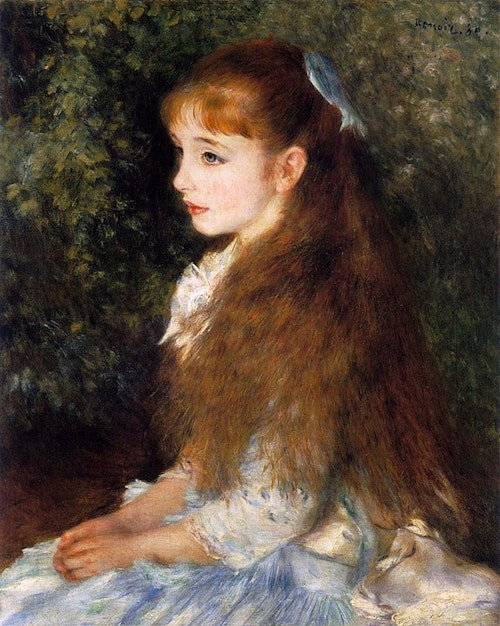
In 1890, he was approached to receive the Legion of Honor, but declined.
Also that year, he exhibited at the Salon for the first time in seven years, and retired from the Salon for the last time.
In the same year, he officially married Aline. Around the same year, the Renoir family moved to "La Brouillarde" (The House of Fog) on Rue Girardon in the hills above Montmartre.
In the early 1890s, he preferred to paint idyllic scenes of farm women and urban women.
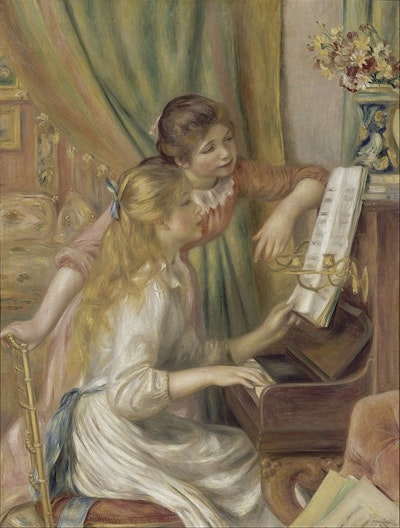
In these paintings, the outlines are not as clear as they were in the 1880s, but the figures are more voluminous, unlike those of the Impressionist period. He also liked to paint nudes.
In February 1919, he was awarded the third degree of the Legion of Honor. That same year, the Louvre Museum purchased "Portrait of Madame Charpentier," and Renoir was invited by the Superintendent of Fine Arts to see his work displayed in the museum of his dreams.
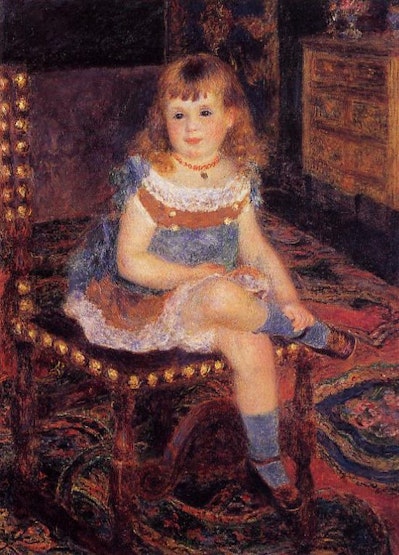
On December 3 of the same year, he died of pulmonary congestion at Les Collettes in Cagnes.
A few hours before his death, Renoir asked for a brush and palette to paint flowers, and when he returned them, he murmured, "I think I'm finally beginning to understand something. When he returned them, he murmured, "I think I'm finally beginning to understand something. The source of this legend is unknown, and according to Durand-Ruel, he is said to have muttered, "I'm finished. According to Durand-Ruel, he also mumbled, "I'm finished.
According to his eldest son Pierre, "For two days he was attacked by congestion in his lungs, but he recovered when his heart stopped. His last moments were stirred, and he often spoke in a state of half-unconscious temporary delirium, but when I spoke to him directly he replied that he was all right. Then he slumbered, and about an hour later he stopped breathing." It is said.
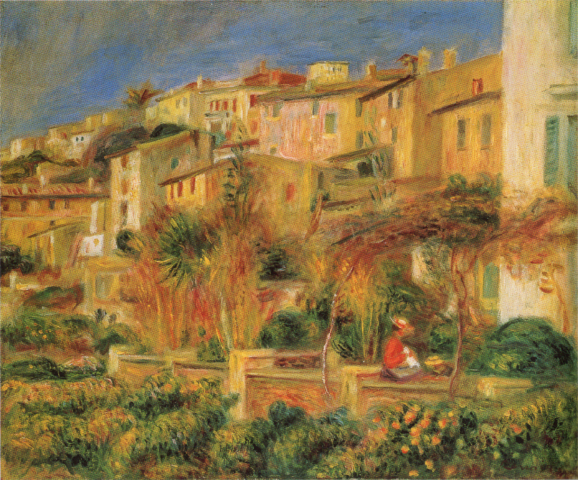
Monet was shocked to hear the news of Renoir's death and said, "It's very painful. I am the only one left. I am the only survivor of my friends. he wrote to a friend.
See the latest works of TRiCERA ART
TRiCERA ART members receive a variety of benefits and preferences.
- Discounts, including members-only secret sales and coupons
- Create My Collection by registering your favorite artists
- Receive updates on popular artists, exhibitions, and events
- Receive a weekly newsletter with selected art
- Personal Assessment to find out what kind of art you like.
Please register as a member for free and receive the latest information.
Free Member Registration